
What have you ever done on Czech sandstone?
Last spring, Adam Ondra finally came to the Peak District and gave gritstone a try. Is it time for British climbers to pay a visit to Czech Republic, following the Wideboyz' example, and even the score? We think so...
Before Kalymnos, Geyikbahiri and Rodellar became the eponyms to desirable venues for the current generation of easy going sport climbers, there were other places magazines would report about. Some of these, such as the Frankenjura, stayed strong through decades. Many other ones, for example Buoux, burnt bright but then faded. But only a few remained just famous enough to become legendary among truly hardcore climbers yet never really popular enough at a global level to risk losing their charm and essence.
These rare locations have a strongly local character and only well rounded and committed outsiders can hope to adapt quickly to the specific rock, climbing style and ethics of the place.
The description I drafted so far fits very well two places apparently very distant from each other: British gritstone and Czech sandstone. And while I'm not as crazy as to think I can teach the Brits about the former, I was daring enough to accept an invitation to get a taste of the latter.
This invitation came from Robin Kaleta, a prominent Czech free-ride skier with a second life as a climber, who's a seasoned organiser of freeriding camps in the Alps. Robin is now turning his experience to climbing in the Czech Republic too. And, boy, is he good at organising trips!
As I flew into Prague on a warm August evening, I was dutifully picked up by Robin, and I joined the other photographers and writers he had invited. The following day, we drove through the plains and hills of north-eastern Bohemia to reach our destination: the sandstone towers and cliffs of Adršpach and Teplice.
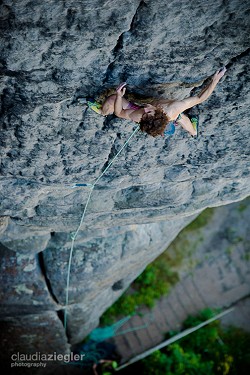
In the afternoon, Robin and one of his guides brought us media folks to the rocks and the climbing weekend began in full.
However, such a unique location required one last element to the mix: an equally unique climber. And our host had thought of that too in the form of nobody less than Adam Ondra, who is fresh from a quick weekend in the Peak District just a few months ago. By climbing there, he put to rest that UKClimbing rolling gag question which often spiced up forum discussions about his sport climbing accomplishment: "what has he ever done on gritstone?". The answer is that he flashed a few E7 classics under the guidance of Neil Gresham. Not bad for a first timer!
Now, before we let Adam compare and contrast his experience in the Peak with that of his native country's sandstone, allow me to quickly summarise what a climbing trip to a destination such as Adršpach and Teplice meant to an outsider like myself:
- A fairy tale landscape of formations offering cracks, chimneys, faces, arêtes and the occasional roof
- Technical climbing on amazing sandstone that will reward excellent footwork, use of slopers and body positioning rather than brute force and finger power
- A true testing ground to ambitious, motivated and committed climbers. You'll need solid onsight skills to lead, as pieces of fixed gear are often far apart, which also hangdogging impractical if not impossible
- A different approach to removable protections, since you'll have to learn how to place knotted slings in cracks and holes
- Anything from camping grounds to self-catering huts and good hotel rooms as accommodations
- A historically rich climbing destination where climbing began as early as the 1920s and just kept going
- A vibrant community of climbers populating the various pub restaurants in the evenings and making the best of the £1 pints of the famous Czech lagers!
Here's the interview with Adam...
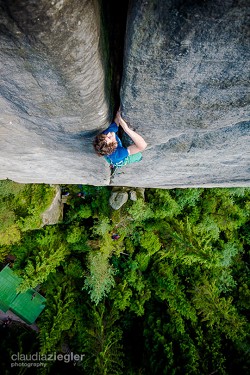
Adam, your record speaks for itself when it comes to the types of rock you have climbed on and the consistency of your performance, having onsighted up to 8c+ on rocks as different as granitic gneiss, limestone and sandstone. What were your expectations as you climbed on gritstone earlier this year?
I didn't have too many expectations, to be honest, but from the many videos I knew routes would be short, bouldery and technical and it was quite the case. It's some very nice technical climbing very similar to Czech sandstone.
And how did it go in the end?
I climbed three E7s: Master's Edge, Messiah and Balance It Is. I really liked the last one.
Knowing that Wolfgang Güllich is one of your favourite climbers and that he fell and got injured on Master's Edge, was this climb something special for you?
Not necessarily, but of course I knew it was a quite legendary route. As I finally got around to climbing on gritstone, I knew I wanted to try the route. One of the reasons it's so famous is that, back in the early 80s, it was one of the hardest routes in the UK. The second reason is probably because of Wolfgang's incident. And it's a very beautiful route too, which also contributed to its legend, I think, even if it's in a quarry.
Do you have any specific plans for trad climbing in the near future?
I did something, but it was French 7c/7c+ at the most. In Flatanger, I opened one 8a+ route onsighting it on trad gear, but the first 5 metres were in common with another route which was already bolted so I'm not really sure it counts! I just started climbing those first few metres (which I already knew) on bolts and then just simply continued all the way to the spot where I stopped to place the anchor I had in mind. That was quite satisfying.
How much longer past the bolted line did you climb on gear?
In total, the route was probably 40 metres. I reckon the line was really easy to protect. There were big run-outs, but even I could see that the placements were bulletproof. Evaluating gear is normally a problem for me when trad climbing because I have so little experience that I can't really tell if the protection is good or not. Which is why it can get risky for me for if I try something hard. Therefore I'd need to climb a lot of routes with some really experienced climbers who could tell me "Ok, this placement is not so great, but this one is" and so on.
How did gritstone compare to Czech sandstone?
The feeling you get from the rock is very similar and so is the climbing style. I would just say that gritstone has probably little less friction.
When people told me about it, everybody was saying that it's a kind of rock that I couldn't possibly have seen before and that was so special, but to me the overall climbing experience felt quite similar to sandstone in Czech Republic.
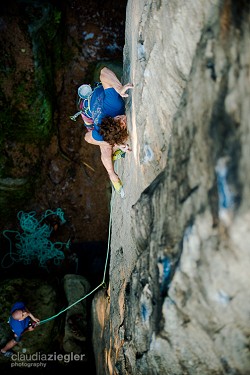
Speaking of which, could you tell us more about the sandstone areas of your home country?
Sure! There are Adršpach and Teplice, where we are now and there are many areas in the so called Czech Paradise (Český ráj) where you have multiple areas such as Prachov and Hrubice. These areas are rather traditional when it comes to ethics (no chalk at all, for example) and offer easier climbing. The rock tends to be a little bit softer than here.
Then, in the northwest of Czech Republic, there's the Elbe valley (Labské údolí or informally Labák in czech) which is the most famous and then there is Ostrov and Tisá. The rock is harder, especially in the Elbe valley. Routes are harder and better protected, you've got fewer cracks, it's more face climbing. Some sections could even remind you of the Grampians in Australia. There is also bouldering both near the Elbe valley and close to Adršpach and Teplice.
Do you think that British trad climbers would enjoy the challenge? How/why?
They would love it, I think. Because it's very similar, but instead of climbing some 8-10 metres you can easily get to climb 50 on the tall towers. In this case, you'd get to the summit, sign the diary and you can rappel quickly off the fixed anchor at the top.
I appreciate the ethics of gritstone, but I thought it was kind of inconvenient not to have anchors on top of routes. Say, if you are a hobby climber and finally a weekend with good weather arrives and you're looking forward to do a lot of pitches on gritstone... You just can't do as many as in most other places. Once you've climbed the route you have to make an anchor, rappel down to clean the route, then hike up to take the anchor off, hike down again and only then can you move on to the next one. On a given day, you can climb so much more ground on a comparable type of rock here. The problem here is that there are no guidebooks in English, and Czech is not really a language one may happen to study in school like French or Spanish. And you need to know something about the route, the placements, you can't really tell from underneath.
What's your approach to risk during climbing?
I believe risk is something you can't avoid in your ordinary life. Even by just getting into your car, you are taking some risks. I always try to evaluate the risks and consequently there are some risks I'm not willing to take and some other ones that I can accept. It's always about the decisions you take. But I have to say, I like to be scared, a little bit. It does add some spice to things in climbing. It occurred to me to realise that I took a bit too much risk... but if I did, it meant I was really enjoying myself in that moment!
But, at the same time, I don't think I will ever free solo, because free soloing long routes seems to be too much risk to me, too much risk you can't control and influence at all.
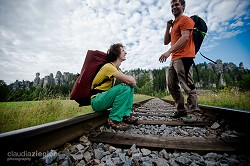
Here in Adršpach and Teplice you sometimes get in a situation where you could hit the ground but, again, as the risk is reduced to five moves or something, I feel like I can focus on those five moves. But if you are doing one hundred moves or more... without any rope at all... that's too much risk for me.
What do you think are the riskiest climb you have done?
I'm pretty sure they were always here on sandstone! If anything, the last climb I did yesterday was quite dangerous I think. *laughs* And that one trad climb in Norway.
Oh yes, the climb he did yesterday. Adam came down after a rather long battle with one of the most historical routes in the valley of Teplice, Udolni at the tower of Hlaska, a route which aroused the interest of the Wideboyz Tom Randall and Pete Whittaker, who commented it to be "beefy" on the summit book.
Supposedly, it was the last climb of the day. But as we went back on the main path, Adam asked photographer Jakub Frey to belay him, as he approached a smooth dihedral. The young Czech took a couple of slings and quickdraws and began to climb up towards the first ring bolt, placed at a height where you would normally see the anchor of an indoor wall. Barefoot.
I did my best to hide my apprehension as I pointed out his shoes were sitting by the coiled rope, but he shrugged it off: "It's nearly the same, on sandstone". Right...
Adam kept laybacking up the crack marking the dihedral, grain of sands peeling off the wall and falling down, joining thousands of their kind already on the ground.
Some tourists stopped to take photos, probably ignorant of the fact that the living treasure of contemporary sport climbing was risking his ankles, neck or even more on a badly protected route in the upper range of French sixth grade.
My silly worries waned gradually as Adam placed a precarious sling in a crack and, finally, reached the ring bolt and then the top of the route. Everything looked normal as he rappelled down and only the following day would he confess that maybe this was one of the riskiest climbs he had been on.
Which probably means there are plenty of consummate gritstone climbers who have done way scarier things, but it's "show me, don't tell me" and the gauntlet has been thrown down to them now...
Therefore, the question really is: "What have you ever onsighted barefoot on very run out Czech sandstone?"
Looking forward to hear some answers! : )
I'd like to thank Adam Ondra for the interview and Robin Kaleta for board, lodging and logistics.
Make sure to check out his website for a better overview of the Czech sandstone areas for which he offers guiding services and organises climbing holidays.
29 November, Adam Ondra goes up against Jimmy Webb, Jan Hojer, Alex Megos, Jernej Kruder and Daniel Woods in the La Sportiva Legends Only bouldering invitational in Stockholm, Sweden.
Until then, enjoy a video documentary about the sandstone scene in the Czech Republic:
Thanks for reading!
Frode Mauritsen
Adam Ondra is sponsored by: Beal, Black Diamond, Entre-Prises, Hudy Sports, La Sportiva and Montura

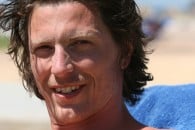

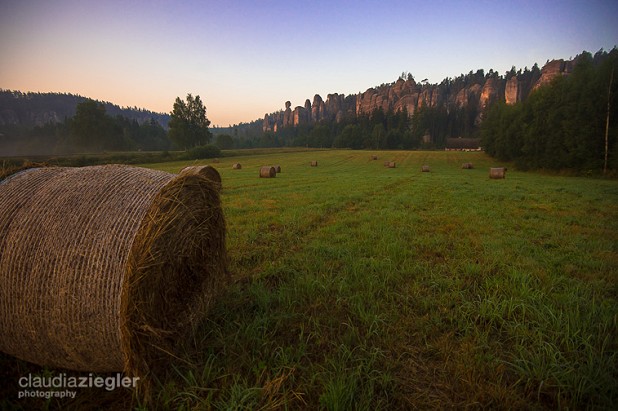


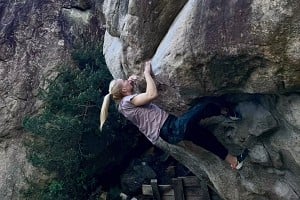
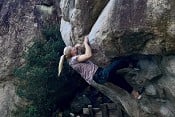


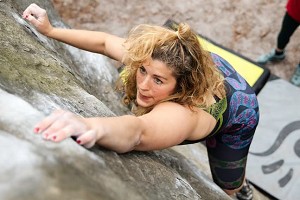
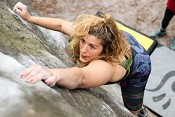
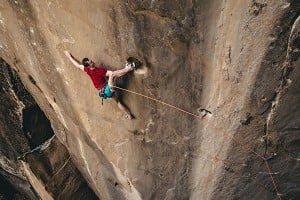
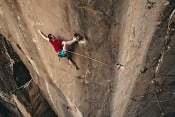
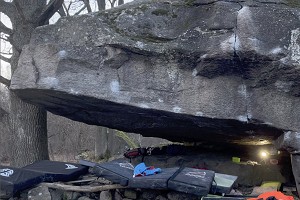
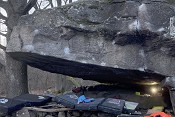
Comments